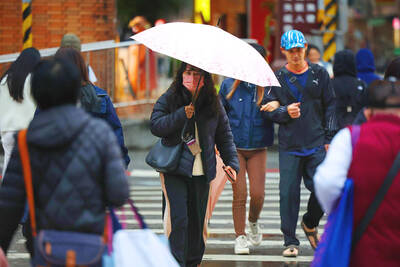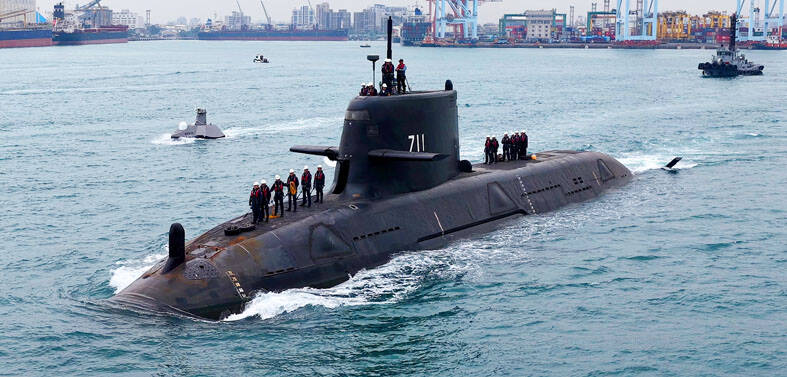While the destruction caused by the series of gas explosions left Greater Kaohsiung streets looking much like a war zone, battle scenes extended to hospital emergency rooms around the city.
The Greater Kaohsiung Government launched its mass casualty response program early yesterday morning, preparing hospitals for the wounded making their way in and for those who were going from one hospital to another, looking for family members.
According to the Ministry of Health and Welfare, the casualties were sent to more than 20 hospitals, including Kaohsiung Medical University Hospital, Veterans’ General Hospital, Chang Gung Memorial Hospital, Yuan’s General Hospital, the Armed Forces General Hospital and Kaohsiung Municipal United Hospitals.

Photo: Lo Hsin-chen, Taipei Times
Most of the injured suffered cuts and burns, the ministry said.
Meanwhile, people were tearful and emotional as they identified their loved ones at the Kaohsiung Municipal Funeral Parlor, some of them venting their anger at officials on the scene, criticizing the government for not doing enough in the rescue effort.
The mother of a victim surnamed Yang (楊) arrived at the funeral parlor with her two sons, and was so overcome by grief she could not stand on her own. She said her daughter ran into an explosion on her way home from work and died instantly.
A man surnamed Hung (洪) mourned his brother-in-law’s wife, who was killed by an explosion on her way home, saying that “this would not have happened to her if she got off work earlier.”
Many people who arrived quickly at the funeral parlor after being notified of their family members’ deaths had to wait hours before seeing the bodies of their loved ones.
Greater Kaohsiung Government Mortuary Services Office Director-General Cheng Ming-hsing (鄭明興) became the target of criticism when he arrived.
Many victims’ families complained that the government did not put enough resources into the rescue effort.
One man, in tears, said a member of his family had been pinned under a big rock, and it took him several hours to remove the rock on his own with his bare hands, with no help from rescuers or officials.
“Who could bring my family back alive?” he shouted.

NUMBERS IMBALANCE: More than 4 million Taiwanese have visited China this year, while only about half a million Chinese have visited here Beijing has yet to respond to Taiwan’s requests for negotiation over matters related to the recovery of cross-strait tourism, the Tourism Administration said yesterday. Taiwan’s tourism authority issued the statement after Chinese-language daily the China Times reported yesterday that the government’s policy of banning group tours to China does not stop Taiwanese from visiting the country. As of October, more than 4.2 million had traveled to China this year, exceeding last year. Beijing estimated the number of Taiwanese tourists in China could reach 4.5 million this year. By contrast, only 500,000 Chinese tourists are expected in Taiwan, the report said. The report

SHIPS, TRAINS AND AUTOMOBILES: The ministry has announced changes to varied transportation industries taking effect soon, with a number of effects for passengers Beginning next month, the post office is canceling signature upon delivery and written inquiry services for international registered small packets in accordance with the new policy of the Universal Postal Union, the Ministry of Transportation and Communications said yesterday. The new policy does not apply to packets that are to be delivered to China, the ministry said. Senders of international registered small packets would receive a NT$10 rebate on postage if the packets are sent from Jan. 1 to March 31, it added. The ministry said that three other policies are also scheduled to take effect next month. International cruise ship operators

Temperatures are forecast to drop steadily as a continental cold air mass moves across Taiwan, with some areas also likely to see heavy rainfall, the Central Weather Administration (CWA) said. From today through early tomorrow, a cold air mass would keep temperatures low across central and northern Taiwan, and the eastern half of Taiwan proper, with isolated brief showers forecast along Keelung’s north coast, Taipei and New Taipei City’s mountainous areas and eastern Taiwan, it said. Lows of 11°C to 15°C are forecast in central and northern Taiwan, Yilan County, and the outlying Kinmen and Lienchiang (Matsu) counties, and 14°C to 17°C

STEERING FAILURE: The first boat of its class is experiencing teething issues as it readies for acceptance by the navy, according to a recent story about rudder failure The Hai Kun (海鯤), the nation’s first locally built submarine, allegedly suffered a total failure of stern hydraulic systems during the second round of sea acceptance trials on June 26, and sailors were forced to manually operate the X-rudder to turn the submarine and return to port, news Web site Mirror Daily reported yesterday. The report said that tugboats following the Hai Kun assisted the submarine in avoiding collisions with other ships due to the X-rudder malfunctioning. At the time of the report, the submarine had completed its trials and was scheduled to begin diving and surfacing tests in shallow areas. The X-rudder,